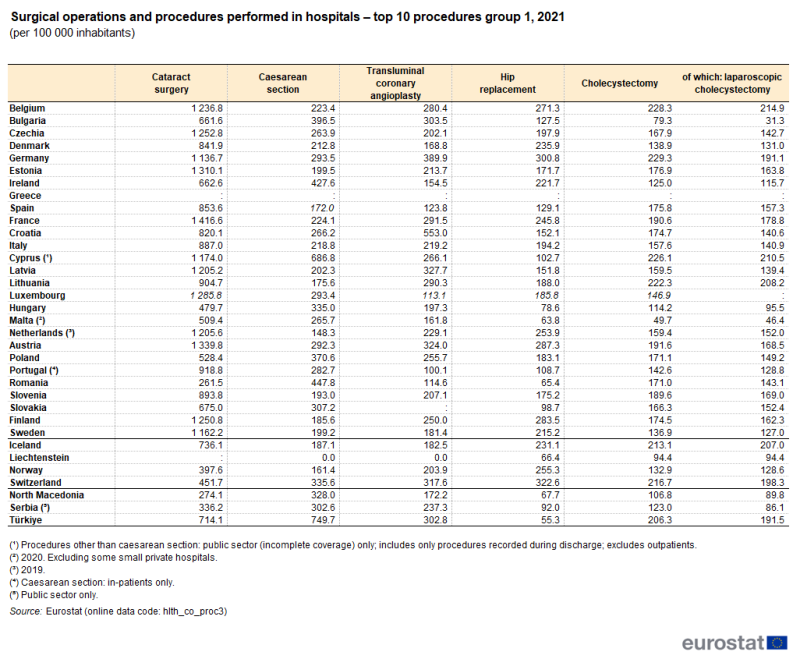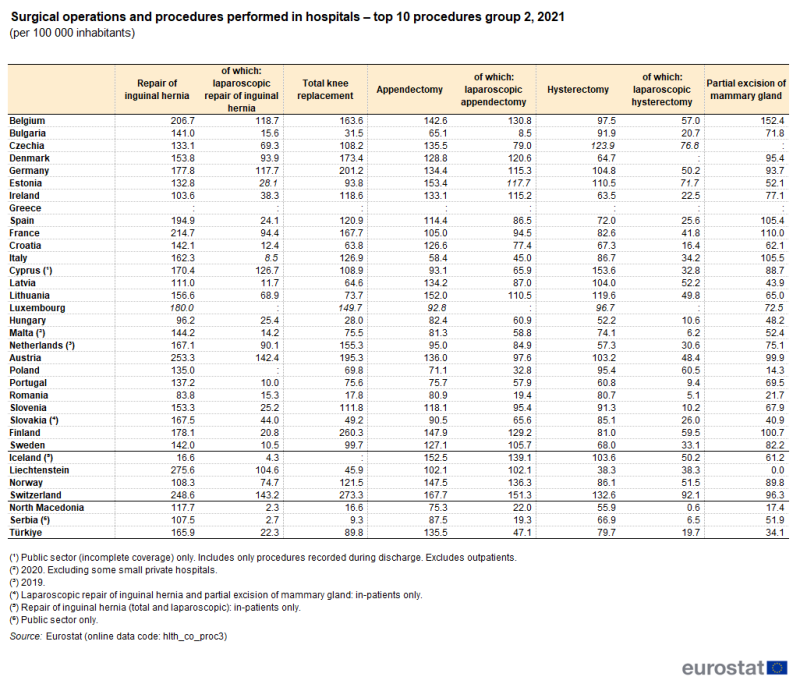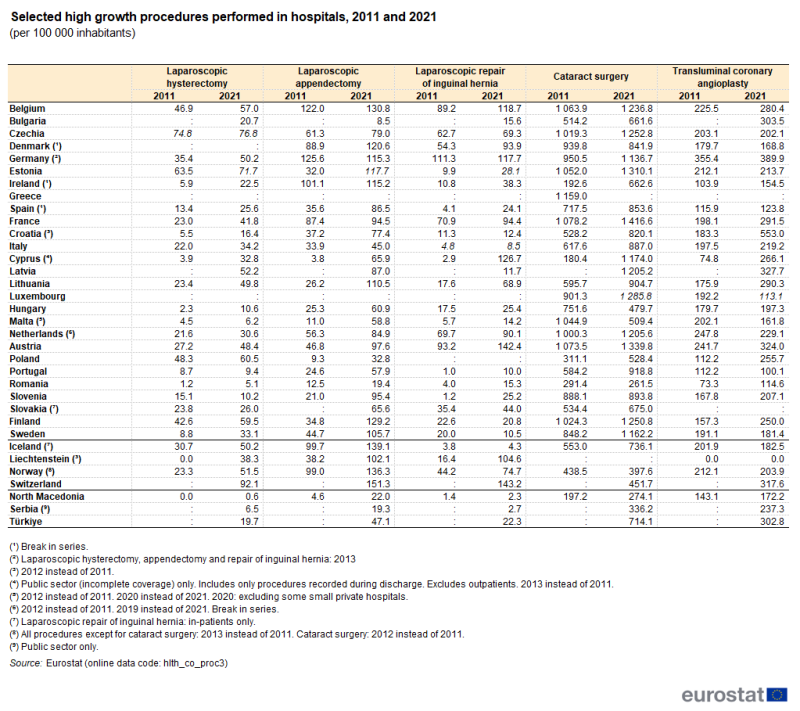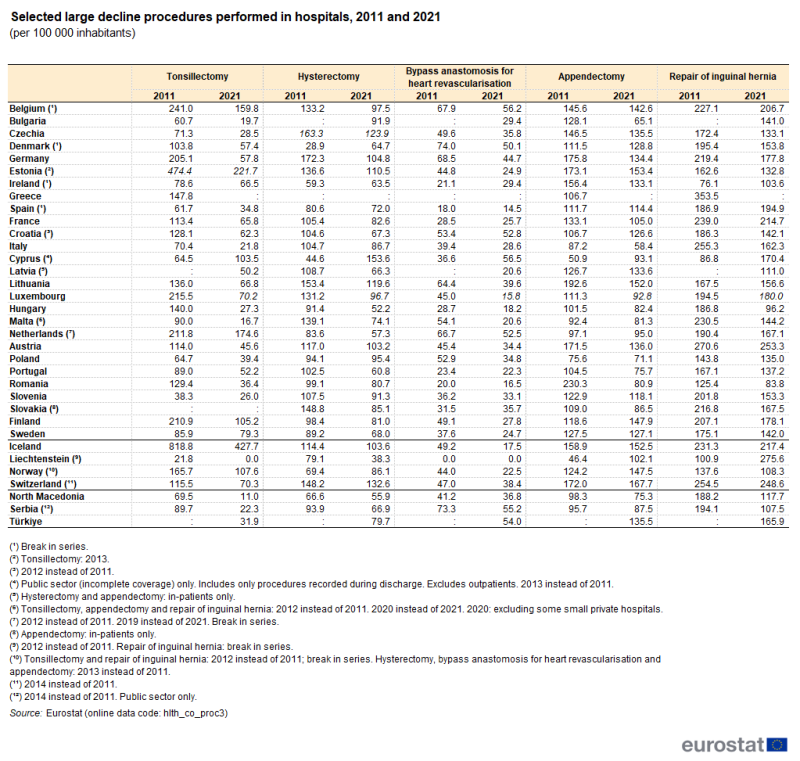Surgical operations and procedures statistics
Data extracted in August 2023.
Planned article update: September 2024.
Highlights
At least 1.14 million caesarean sections performed in the EU in 2021.
Large positive rates of change reported in recent years by most EU Member States for keyhole surgery used to perform hysterectomies, appendectomies and repairs of inguinal hernias.
In nearly all EU Member States, there has been a fall in recent years in the use of in-patient procedures for cataract surgery.
Cataract surgery, 2021
This article presents an overview of European Union (EU) statistics related to surgical operations and procedures. It provides information for a selection of the most common surgical operations and procedures as well as those that are being performed either more or less frequently than 10 years ago. These operations and procedures are classified according to the International Classification of Diseases – clinical modification (ICD-9-CM).
This article is one of a set of statistical articles concerning healthcare activities in the EU which forms part of an online publication on health statistics.
It should be noted that data are presented in this article for 2021. As such, this article includes data that may have been impacted by the COVID-19 pandemic and its related restrictions. For this reason, particular attention should be paid when comparing the 2021 data with data from earlier years.
In some EU Member States, healthcare activities were impacted (particularly at the start of the pandemic) by an influx of patients with COVID-19. The pandemic also resulted in a range of knock-on effects including, among others, some services being curtailed/postponed due to the number of COVID-19 patients, staff shortages within hospitals and day care centres due to infection/quarantine procedures, and patients being hindered in accessing medical services due to their own infection/quarantine as well as lockdown or travel restrictions.
Full article
Number of surgical operations and procedures
The two most common surgical operations and procedures performed in EU hospitals (for which data are collected) were cataract surgery and caesarean sections
Tables 1 and 2 indicate how frequently a selection of the most common surgical operations and procedures were conducted in 2021. In both tables, the data are presented relative to the size of the population (per 100 000 inhabitants). For several of these operations and procedures, such as cholecystectomies (the surgical removal of the gallbladder), information is given on the frequency with which these are carried out laparoscopically – in other words, using minimally invasive surgery (this technique involves performing an operation through only a small incision in the body and is also known as keyhole surgery) – as well as a total figure.

(per 100 000 inhabitants)
Source: Eurostat (hlth_co_proc3)
Cataract surgery (ICD-9-CM codes 13.1–13.8), the extraction of the lens from an eye, was conducted 4.32 million times in 2021 across the EU Member States (Malta, 2020 data; the Netherlands, 2019 data; Greece, no recent data available), making this the most common of the surgical operations and procedures presented in this article. In 12 of the Member States, cataract surgery was performed 1 000 times or more per 100 000 inhabitants in 2021 (or another recent year – see Figure 1 for details of coverage), peaking at 1 417 times per 100 000 inhabitants in France. By contrast, cataract surgery was performed less than 500 times per 100 000 inhabitants in Hungary and Romania.
At least 1.14 million caesarean sections performed in the EU
Another common procedure was a caesarean section (ICD-9-CM codes 74.0–74.2, 74.4 and 74.99), in other words, the delivery of one or more babies through an incision in a mother's abdomen and uterus. In 2021, this procedure was performed at least 1.14 million times in the EU (Malta, 2020 data; the Netherlands, 2019 data; Portugal, in-patients only; Greece, no recent data available). A total of 244 200 caesarean sections were performed in Germany, while between 129 400 and 151 900 caesarean sections were performed in France, Poland and Italy; note also the high number of caesarean sections performed in Türkiye (630 900) in 2021.
In most of the EU Member States, between 150 and 400 caesarean sections were performed per 100 000 inhabitants in 2021 (see Figure 2), with this procedure more frequent in Ireland, Romania and Cyprus, and less frequent in the Netherlands (2019 data).
Transluminal coronary angioplasties concern the opening up of blocked coronary arteries (ICD-9-CM codes 36.01, 36.02 and 36.05). In 2021, transluminal coronary angioplasties were most common (relative to population size) in Croatia and Germany where they were performed on average 553 and 390 times per 100 000 inhabitants respectively. They were conducted between 154 and 328 times per 100 000 inhabitants in most of the remaining EU Member States for which data are available, with Spain, Romania, Luxembourg and Portugal below this range.
Hip replacements (ICD-9-CM codes 81.51–81.53) were performed 301 times per 100 000 inhabitants in Germany in 2021 and between 271 and 287 times per 100 000 inhabitants in Austria, Finland and Belgium; these were the highest frequencies among the EU Member States for which data are available (see Table 1). Less than 100 hip replacements were performed per 100 000 inhabitants in Slovakia, Hungary, Romania and Malta (2020 data).
In general, the frequency of cholecystectomies (ICD-9-CM codes 51.22 and 51.23) varied less between the EU Member States than did most other procedures presented in Tables 1 and 2. Concerning laparoscopic cholecystectomies, the frequency in 2021 was highest in Belgium, Cyprus and Lithuania, all above 200 per 100 000 inhabitants. It was lowest in Hungary, Malta (2020 data) and Bulgaria, the only Member States to record ratios below 100 per 100 000 inhabitants. The share of cholecystectomies that were performed laparoscopically varied little: with the exception of Bulgaria (40 %), the vast majority of cholecystectomies were performed laparoscopically, their share in 2021 ranging from 80 % in Croatia to 95 % in the Netherlands (2019 data).

(per 100 000 inhabitants)
Source: Eurostat (hlth_co_proc3)
Repairs of inguinal hernias involve covering the hernia defect with mesh from within the abdomen in order to patch it (ICD-9-CM codes 53.0 and 53.1). Repairs of inguinal hernia were typically undertaken between 130 and 220 times per 100 000 inhabitants in 2021, with Austria reporting a higher frequency (253 per 100 000 inhabitants) while Latvia, Ireland, Hungary and Romania reported lower frequencies (no more than 111 per 100 000 inhabitants). A majority of these repairs were undertaken laparoscopically in Cyprus (with a peak of 74 %), Germany, Denmark, Belgium, Austria, the Netherlands (2019 data) and Czechia. This share was below 50 % in the remaining EU Member States for which data are available; the share was below 10 % in five of the EU Member States and was lowest in Italy (at 5 %).
The frequency of knee replacements (ICD-9-CM code 81.54) varied more between the EU Member States than did hip replacements. Furthermore, with the exceptions of Cyprus and Malta, total knee replacements were less common than hip replacements in 2021. More than 200 knee replacements per 100 000 inhabitants were performed in Finland and Germany, compared with less than 50 per 100 000 inhabitants in Slovakia, Bulgaria, Hungary and Romania.
The frequency of appendectomies (removal of an (infected) appendix; ICD-9-CM codes 47.0 and 47.1) varied less between the EU Member States than did most other procedures presented in Tables 1 and 2 and much less than the frequency of laparoscopic appendectomies. The frequency of the latter in 2021 was higher in Belgium and Finland than in the other EU Member States, while it was lowest in Italy, Poland, Romania and Bulgaria. The share of appendectomies that were performed laparoscopically varied greatly, from 13 % of the total number of these procedures in Bulgaria to 90 % or higher in France, Belgium and Denmark.
Another common procedure performed within the EU was hysterectomies (the removal of all or part of the uterus; ICD-9-CM codes 68.3–68.7 and 68.9). Hysterectomies were most frequently performed in 2021 in Cyprus (154 per 100 000 inhabitants). In all of the other EU Member States the frequency ranged from 52 to 124 per 100 000 inhabitants. More than half of all hysterectomies in Finland, Estonia, Poland, Czechia, Belgium, the Netherlands (2019 data), France and Latvia were performed laparoscopically. The share of hysterectomies performed laparoscopically was below 20 % in four Member States, with the lowest shares – the only ones below 10 % – in Malta (8 %, 2020 data) and Romania (6 %).
The frequency of partial excisions of mammary glands (ICD-9-CM codes 85.2–85.23) varied quite considerably between the EU Member States in 2021. In Belgium, this procedure was performed 152 times per 100 000 inhabitants while in Poland it was performed 14 times per 100 000 inhabitants.
Increasing and decreasing surgical operations and procedures
Large increases reported for hysterectomies performed using keyhole surgery
A selection of surgical operations and procedures which have generally become more frequent during recent years is presented in Table 3; three of these concern laparoscopic techniques. Data are usually presented for 2011 and 2021: alternative years are presented for some EU Member States and non-EU countries – see Table 3 for the precise coverage.

(per 100 000 inhabitants)
Source: Eurostat (hlth_co_proc3)
Within the EU, the most rapid increase in absolute numbers of operations/procedures between 2011 and 2021 was observed for laparoscopic hysterectomies (keyhole surgery to remove all or part of the uterus). Relative to population size, the frequency of laparoscopic hysterectomies increased in 21 of the 22 EU Member States for which data are available, the exception being Slovenia. Seven Member States reported the frequency of this procedure more than doubling during the period under consideration. The largest relative increase was in Cyprus where it was approximately eight times as common in 2021 as it had been in 2013 (up from 3.9 to 32.8 procedures per 100 000 inhabitants).
Among the 22 EU Member States for which data are available for 2011 and 2021, all but one reported an increase in laparoscopic appendectomies; the exception was Germany where the frequency relative to the population size fell. The frequency of this procedure more than doubled in 13 Member States. The highest increases were observed in Malta (2012–2020) and Cyprus (2013–2021), where the frequencies were 5.4 and 17.2 times as high in the most recent year as in the earlier year.
Between 2011 and 2021, the frequency of laparoscopic repair of inguinal hernia increased in 20 of the 22 EU Member States for which data are available. In Finland, there was a relatively small decrease and in Sweden a larger one. In nine Member States, the frequency of this procedure more than doubled during the period under consideration. By far the largest relative increases were observed in Slovenia and Cyprus, the frequency being 20.6 times as high in 2021 as in 2011 in the former and 43.7 times as high in 2021 as in 2013 in the latter.
A total of 21 out of 25 EU Member States for which data are available for 2011 and 2021 reported an increase in the frequency of cataract surgeries, the most common procedure among those shown in Table 3. The exceptions were Malta (2012–2020), Hungary, Denmark (where there is a break in series) and Romania, where the frequency declined. The largest increase was in Cyprus, where the frequency was nearly seven times as high in 2021 as in 2013.
Transluminal coronary angioplasty was the second most common procedure among those shown in Table 3. In 17 out of the 23 EU Member States for which data are available, the frequency of transluminal coronary angioplasties increased between 2011 and 2021 (see Table 3 for the precise coverage). The largest increase was in Cyprus, where the frequency in 2021 was 3.6 times as high as in 2013. Elsewhere, large increases were observed in Croatia (2012–2021) and Poland. The decrease in frequency observed in six Member States was most substantial in Luxembourg, down more than two-fifths.
Tonsillectomies were performed with a decreasing frequency
A selection of surgical operations and procedures which have become less common in recent years is presented in Table 4. Three of these – hysterectomies, appendectomies, and repairs of inguinal hernias – are procedures whose overall frequencies have declined despite relatively fast growth in their performance using laparoscopic techniques. In other words, the increase in the frequency of these procedures using laparoscopic techniques was less than the overall decrease in these procedures. Data are generally presented for 2011 and 2021: alternative years are presented for some EU Member States – see Table 4 for the precise coverage.

(per 100 000 inhabitants)
Source: Eurostat (hlth_co_proc3)
The removal of tonsils, a tonsillectomy, remains a relatively common procedure despite a decline in its frequency. Among 24 EU Member States for which data are available, the frequency of tonsillectomies fell in 23 between 2011 and 2021; the only increase was reported in Cyprus (2013–2021). The sharpest declines in the frequency of tonsillectomies were recorded in Hungary and Malta (2012–2020), down by more than four-fifths.
A total of 25 EU Member States have data available for the frequency of hysterectomies. Cyprus (2013–2021), Denmark, Ireland and Poland were the only Member States to report an increase in the frequency of this procedure between 2011 and 2021, although a break in series was observed in Denmark and Ireland. The frequency fell by a quarter or more in 10 Member States.
For bypass anastomosis for heart revascularisation (a bypass operation that concerns one or more coronary arteries), 21 of the 24 EU Member States for which data are available reported a decline in the frequency between 2011 and 2021. The frequency of carrying out bypass anastomosis for heart revascularisation increased greatly in Cyprus and in Ireland, although there is a break in series for the latter. A more modest increase was observed in Slovakia. Decreases of more than two-fifths in the frequency were reported for Finland and Estonia, while in Malta (2011–2020) and Luxembourg the frequency in the most recent year was more than three-fifths lower than it had been in 2011.
Among the 26 EU Member States for which data are available, 19 recorded a lower frequency of appendectomies in 2021 than in 2011. The frequency of this operation was down by around two-thirds in Romania and approximately halved in Bulgaria during the period under consideration. The largest increase in the frequency of this procedure was observed in Cyprus (2013–2021).
Among 24 EU Member States for which data are available, 21 reported decreases in the frequency of repairs of inguinal hernias between 2011 and 2021. The most notable exception was Cyprus (2013–2021), where the frequency nearly doubled. Smaller increases were observed in Ireland and Spain, both of which have a break in series. There were four Member States where the frequency of carrying out a repair of an inguinal hernia fell by more than a quarter, among which Hungary recorded a decrease of nearly half.
In-patient procedures: cataract surgery
Widespread fall in the use of in-patient procedures for cataract surgery
As already noted, one of the most common procedures conducted in the EU is cataract surgery. Several decades ago, this procedure required admission as an in-patient. Figure 3 shows that this is no longer the case in many of the EU Member States (no data available for Greece). In 2021, less than 10.0 % of procedures for cataract surgery were carried out as in-patient procedures in 19 of the Member States. The lowest shares – less than 1.0 % – were recorded in Denmark, Spain, Slovenia, Cyprus and the Netherlands (2019 data). There were two Member States where more than half of the procedures for cataract surgery in 2021 were performed on in-patients: Bulgaria (55.2 %) and Romania (54.5 %).

(%)
Source: Eurostat (hlth_co_proc3)
Between 2011 and 2021, the share of procedures for cataract surgery carried out on in-patients fell in nearly every EU Member State for which data are available. The exceptions were Finland and Estonia where the low shares increased but remained lower than in a majority of the other Member States. In 16 Member States, the share of these procedures carried out on in-patients fell by more than half. The largest relative decrease was in Cyprus, where the share of surgery carried out on in-patients fell from 98.3 % in 2013 to 0.2 % in 2021.
Source data for tables and graphs
Data sources
Key concepts
Surgical procedures are all types of medical interventions involving an incision with instruments mostly performed in an operating theatre, which normally involves anaesthesia and/or respiratory assistance. Surgical procedures can be performed as in-patient cases, day cases or out-patient cases.
Only the main procedure performed on a patient whether during a hospital stay, day case or out-patient treatment should normally be reported.
An in-patient is a patient who is formally admitted (or 'hospitalised') to an institution for treatment and/or care and stays for a minimum of one night or more than 24 hours in the hospital or other institution providing in-patient care. An in-patient or day care patient is discharged from hospital when formally released after a procedure or course of treatment (episode of care). A discharge may occur because of the finalisation of treatment, signing out against medical advice, transfer to another healthcare institution, or because of death.
Healthcare resources and activities
Statistics on healthcare resources and healthcare activities (such as information on surgical operations and procedures) are documented in this background article which provides information on the scope of the data, its legal basis, the methodology employed, as well as related concepts and definitions.
For surgical operations and procedures, the International Classification of Diseases – clinical modification (ICD-9-CM) is used.
For country specific notes, please refer to the annexes at the end of the national metadata reports accessible from links at the beginning of the European metadata report. In particular, note that:
- data for Cyprus generally only concern public hospitals and exclude outpatients; however, coverage is complete for caesarean sections;
- data for Malta exclude some small private hospitals;
- data for Serbia only concern public hospitals.
The Healthcare non-expenditure statistics manual provides an overview of the classifications, both for mandatory variables and variables provided on voluntary basis.
Symbols
Tables in this article use the following notation:
| Value in italics | estimate or provisional data; |
| Value is : | not available. |
Context
For any particular type of surgical operation or procedure, the extent to which this is performed is influenced by a number of factors, including the size of the population and the incidence of the underlying disease or injury among the population. Other factors include differences in medical practices between countries and the availability of financial, technical and human resources.
The European core health indicators (ECHI) shortlist includes an indicator on 'selected surgeries' for 11 categories of surgical operations and procedures performed in hospitals in the chapter on health interventions: health services indicators.
Direct access to
Online publications
Health status – selected diseases and related health problems
Healthcare activities
- Consultations
- Hospital discharges and length of stay
- Medicine use
- Cancer screening statistics
- Unmet needs for health care
Methodology
General health statistics articles
- Health (hlth)
- Health care (hlth_care)
- Health care activities (hlth_act)
- Operations, procedures and treatment (hlth_oper)
- Surgical procedures (hlth_co_proc3)
- Operations, procedures and treatment (hlth_oper)
- Health care activities (hlth_act)
- Healthcare non-expenditure statistics (ESMS metadata file – hlth_res_esms)

